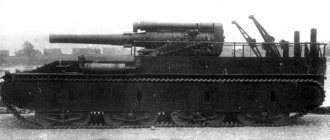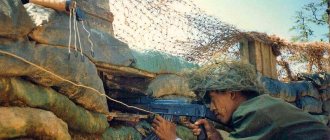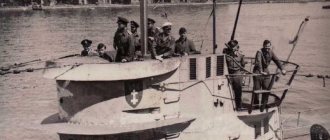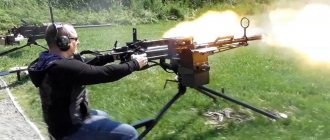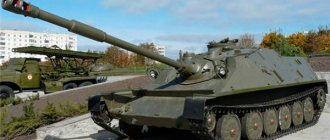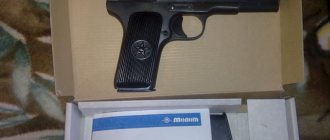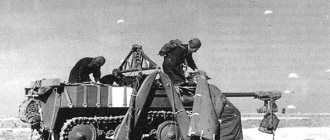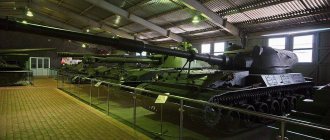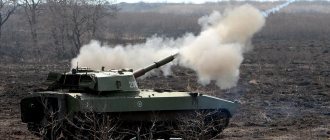Anti-aircraft gun ZSU-57-2. Armament. Dimensions. Booking
Following the results of World War II, it became clear that field anti-aircraft guns were ineffective against low-flying targets, and with the increase in the speed and survivability of aircraft, the effectiveness of 20-mm and 37-mm automatic guns also decreased - the consumption of shells per shot down aircraft increased by 1.5-2 times. It was necessary to increase the rate of fire of anti-aircraft guns and equip them with a mechanism for quickly changing aiming in order to track a high-speed maneuverable target. The advantage in this area was provided by multi-barrel installations on a cross-country chassis, which, as a rule, were also armored.
Anti-aircraft gun ZSU-57-2 - video
In 1955, the Soviet Army adopted the 57-mm ZSU-57-2 anti-aircraft self-propelled gun, designed to protect tank units. Created on the basis of units of the T-54 tank, it had an armored hull and a circular rotation turret open at the top, in the front of which there was a twin 57-mm S-68 automatic cannon with an electro-hydraulic guidance drive. If necessary, the gun could be aimed manually. An automatic anti-aircraft sight was used for firing. Two gunners set the initial target data on it. If the automatic system failed, a conventional mechanical sight was also provided. The ZSU-57-2 ammunition consisted of 300 unitary rounds placed in five-round cassettes along the sides of the turret and hull. The clips were fed manually, and thanks to the automatic reloading device, the gun's rate of fire reached 240 rounds per minute. The horizontal firing range was 12,000 m, and the vertical range was 8,800 m. The spent cartridges were fed through a conveyor belt through a special window into a basket located behind the rear wall of the turret.
ZSU-57-2 were delivered to foreign countries and received their baptism of fire during the Vietnam War. Powerful automatic cannons were also effectively used to combat ground targets. However, the rate of fire of the installations was not high enough for high-speed air targets, and besides, they fired only from a place. Therefore, at the end of the 60s, vehicles of this type began to be replaced in the Soviet Army by the ZSU-23-4 Shilka.
Ammunition for the 57 mm S-68 cannon
Options and modifications[edit]
Object 510[edit]
Based on the order of the Ministry of Transport Engineering No. 0013 of February 8, 1956, the design bureau of plant No. 174, together with plant No. 342, developed a modification of the ZSU-57-2, equipped with individual watercraft. The project manager was A.E. Sulin. The car was assigned the index “Object 510”.
In 1956, two prototypes were manufactured and passed state tests. In 1961, the Object 510 was put into service. A total of 6 production vehicles were produced.
“Object 510” differed from the basic version by installing a device for hanging steel pontoons. The pontoons were intended for crossing water obstacles both under their own power and in tow.
The weight of the vehicle with pontoons was 37.8 tons. Buoyancy reserve - 40%. When moving on water, two propellers were used. Movement on water was allowed with waves up to 5 points. The width of the water barrier, overcome independently, was 50-60 km. The maximum speed afloat was 12 km/h. The maximum speed when towing is no more than 15 km/h.
In addition, when the sea state was up to 2 points, shooting at anti-aircraft targets was ensured. It was also possible to transport troops on a boat of up to 40 people, but shooting was prohibited.
Object 520[edit]
By the end of the 1950s, due to the development of jet aviation, maximum speeds increased to 1000-1200 km/h, and maneuverability increased. Therefore, to effectively counter such targets, automated aiming drives in combination with radar systems were needed.
In accordance with the Decree of the Council of Ministers of the USSR No. 416-211 dated April 17, 1957, the ZSU-57-2 was modernized in the design bureau of Plant No. 174. The modernization consisted of installing 57-mm SV-68 "Berezina" cannons and small-sized radio-optical instrument systems for autonomous fire control "Desna". G.V. Mazepa was appointed project manager, and the project received the index “Object 520”.
In 1959, 6 vehicles were manufactured that passed the PSI, but the Object 520 self-propelled gun was not accepted for service.
Performance characteristics of ZSU-57-2
— Developer: Omsk — Years of production: 1955—1960 — Years of operation: since 1950 — Number of units produced, pcs.: 857 — Layout diagram: classic double-barreled twin
— Crew, people: 6
Weight ZSU-57-2
— Combat weight, t: 28
Overall dimensions of ZSU-57-2
— Body length, mm: 6220 — Length with gun forward, mm: 8480 — Width, mm: 3270 — Height, mm: 2750 — Ground clearance, mm: 425
Reservation ZSU-57-2
— Armor type: steel homogeneous — Hull forehead, mm/deg.: 8—13
Armament ZSU-57-2
— Caliber and brand of gun: 2 × 57-mm S-68 — Type of gun: rifled small-caliber automatic gun — Barrel length, calibers: 76.6 — Gun ammunition: 150 per barrel — VN angles, degrees: −5…+85 ° — Sights: automatic anti-aircraft, construction type
Engine ZSU-57-2
— Engine type: V-54 — Engine power, l. p.: 520
Speed ZSU-57-2
— Speed on the highway, km/h: 50 — Speed on rough terrain, km/h25—30
— Cruising range on the highway, km: 400–420 — Cruising range over rough terrain, km: 300–320
— Specific power, l. s./t: 18.6 — Suspension type: individual torsion bar
— Overcome ascent, degrees: 30° — Overcome wall, m: 0.8 — Overcome ditch, m: 2.7 — Overcome ford, m: 1.4
Combat use[edit]
SU-57-2 were sent to arm anti-aircraft artillery batteries of two-platoon tank regiments, 2 units per platoon (4 units in total). Due to the small volume of production, some of the batteries were equipped with ZTPU-2 installations on the chassis of the BTR-40 and BTR-152 armored personnel carriers instead of the ZSU-57-2.
The combat effectiveness of the ZSU-57-2 depended on the qualifications of the crew, the training of the platoon commander, and was due to the absence of a radar in the guidance system. Effective lethal fire could only be fired from a stop; firing “on the move” at air targets was not provided. The comparative firing efficiency of the ZSU-57-2 was lower than that of the S-60 gun batteries, since the latter had PUAZO-6 with SON-9, and later the RPK-1 Vaza radar instrument system. The effectiveness of using the ZSU-57-2 was higher due to its constant readiness to open fire, self-propelled mode, and the presence of armor protection for the crew.
ZSU-57-2 were used in the Vietnam War, in the conflicts between Israel and Syria and Egypt in 1967 and 1973, as well as in the Iran-Iraq War. Due to the relatively low rate of fire and the lack of automated radar guidance devices, this vehicle was not very effective.
In April 2014, video footage of the use of ZSU-57-2 by the Syrian army in battles in the vicinity of Damascus appeared.
In addition to the listed factors (low rate of fire and lack of automated radar guidance devices), to assess the effectiveness of the installation, it is necessary to take into account the following: In the period 1950-1957 (the period of the creation of the ZSU-57-2), foreign armies did not have the best ZSU. The US Army had the M19 ZSU on the chassis of the M24 Chaffee light tank, developed in 1945, and the M42 on the chassis of the M41 light tank, which entered service with the troops since 1954. Armament: twin 40mm Bofors cannon. The British Armed Forces had a self-propelled gun based on the Crusader tank, created in 1943, armed with a single-barrel 40 mm Bofors L60 cannon. All these installations were available in small quantities, especially in comparison with the number of front-line aviation of the USSR Air Force. The 40-mm Bofors L60 cannon had a rate of fire of 120 rounds/min per barrel, a muzzle velocity of 875 m/s, and a projectile weight of 0.934 kg, that is, it was ballistically inferior to the S-68 gun in all significant respects. All these installations were equipped with optical sights and therefore were not more effective than the ZSU-57-2. Only in 1956 did the first installations of the M42A1 ZSU with the T50 radar appear, but their number was also small.
The combat effectiveness of the ZSU-57-2, like other contemporary ZSUs, was determined not by the level of the installation itself, but by the rapid development of aviation, primarily by the increase in speed and all-weather capability of front-line aviation, to which regimental-level air defense ZSUs in the 1950s had practically nothing to oppose , and also by the fact that all the latest achievements in radio electronics were introduced primarily in artillery and aviation.
In addition, in the armed forces of all states in the 1950s, tactics and an approach to covering mechanized units on the march from modern aircraft were not developed, just as aviation did not develop tactics for reliably destroying small armored targets at high aircraft speeds.
Further, when assessing the combat effectiveness of the ZSU-57-2, it is necessary to take into account that it was not the only air defense system of a tank regiment, but a collective air defense system against aircraft flying at altitudes up to 4000 m, since altitudes up to 1000 m were covered by DShK/DShKM anti-aircraft machine guns , of which there were as many in the tank regiment as there were armored vehicles.
Therefore, criticism of the Soviet system in particular is, for the most part, unfounded and does not take into account the balance of forces of the USSR Air Force and possible opponents in specific theaters of operations. According to the calculations of military experts, the advancing tank and mechanized divisions were reliably covered by front-line fighter aircraft on the MiG-15 (more than 13,000 produced), MiG-17 (more than 7,000) and MiG-19 (about 1,800), and the enemy fighter aircraft, smaller in number , than the Soviet one, was associated with counteracting strike aircraft on the Il-28 (about 6000 were produced), so the mass use of the ZSU was not envisaged.
In addition, criticism does not take into account the fact that the introduction of the ZSU-57-2 went in parallel with the saturation of military air defense with S-60 systems, which were more effective when brought into a combat position, which was achieved in 2 minutes, and that the development of the ZSU-57-2 57-2 helped in developing the optimal structure of self-propelled anti-aircraft units.
Photo ZSU-57-2
Hungarian ZSU-57-2
ZSU-57-2 - photo from the October Revolution parade on November 7, 1956
Destroyed ZSU-57-2 in Vietnam
Similar
ZSU-23-4 Shilka. Rate of fire. Armament. Dimensions. Weight
S-75 air defense systems Dvina, Desna, Volkhov. Compound. Rockets. Damage range
ZRPK Pantsir-S1. Armament. Price. Detection range
S-350E Vityaz air defense system. Compound. Rockets. Damage range
OSA-AKM air defense missile system. Firing range. Rockets. Compound. Dimensions. Weight
ZSU 2S6M Tunguska-M. Damage range. Rockets. Compound. Dimensions
ZRK 2K12 KUB. Damage range. Rocket speed. Principle of operation
SAM Buk-M1-2. Detection and destruction range. Rockets. Possibilities
SAM S-200 Angara, Vega, Dubna. Damage range. Compound. Principle of operation
MANPADS 9K310 Igla-1. Damage range. Weight. Possibilities
SAM 9K331 Tor-M1. Damage range. Rocket. Principle of operation
MANPADS Verba. Damage range. Rocket. Composition of the complex
SAM S-125 Neva (Pechora) Range and height of destruction. Rockets
S-400 Triumph air defense system. Damage range. Rockets. How does it work
SAM 9K35 Strela-10. Damage range. Modifications. Rockets
SAM S-300PMU2 Favorite. Damage range. Compound. Rockets
SAM S-25 Berkut. Range and altitude of damage. Rockets
SAM Sosna. Armament. Damage range. Rockets. Compound
American Patriot air defense system. Damage range. Compound. Rockets
Naval air defense missile system Dagger. Damage range. Compound. Rockets. On what ships is it installed?
ZRK 2K11 Circle. Damage range. Modifications. Compound
Anti-aircraft gun ZSU-57-2. Armament. Dimensions. Booking
KTPU "Gibka" (3M-47) Damage range. Rockets. Principle of operation
"Osa-M" - shipborne anti-aircraft missile system
MANPADS 9K34 "Strela-3"
FIM-92A Stinger - American MANPADS
S-300V (9K81) - anti-aircraft missile system
9S482M7 (PU-12M7) - battery-operated mobile control station
SAM "Avenger" - American mobile anti-aircraft missile system
MANPADS 9K32 "Strela-2"
SAM M-1 "Volna" (4K90) - ship-based anti-aircraft missile system
MD-PS - anti-aircraft missile system
ZSU-37 - self-propelled anti-aircraft gun
